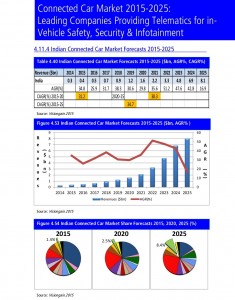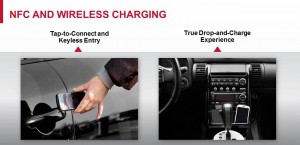By Michael Hurston
Broadcom Executive Vice President, Worldwide Sales
Fifty years ago, Gordon E. Moore predicted that “the number of transistors in a dense integrated circuit will double approximately every two years.” Today, up to two billion transistors fit on the same size die that Moore said might hold thousands. After more than 50 years of exponential silicon growth, the industry is poised for another tremendous transformation. The Internet of Things (IoT) has arrived—a world of hyper connectivity that promises to transform the very way we live.
Within the vast realm of the IoT, the Internet of Vehicles (IoV) is one of the fastest growing segments. It promises to transform the automobile with incredible new features like car connectivity, advanced driver safety and in-vehicle infotainment, ultimately putting it on par with the home and office as a key consumer space. The impact of this seismic shift in automotive design promises to be tremendous, literally changing the way consumers interface with their cars, and it holds particular interest for India.
The Connected Car Heads to India
Over the next 10 years, revenue from connected cars in India is expected to top $8 billion, according to research analyst firm, Visiongain. One reason for the growth is that many consumers are ready and willing to embrace the advanced convenience and safety features of the connected car.
In 2013, the Reva Electric Car Company introduced the Mahindra e20, India’s first connected car. The company also partnered with Vodafone to provide machine-to-machine communication services to the Mahindra e2o. And these aren’t the only companies working to bring connected car capabilities to the fast-growing Indian automotive market.
At the heart of the connected car are the semiconductor chips that make connectivity possible. As the development pace quickens, analysts predict that the number of chips used in vehicles will also increase. According to recent analyst data, there could be nearly 1,000 chips per vehicle by 2020.
Let’s take a closer look at the advanced technologies driving the IoV forward.
Wi-Fi® Connectivity
Inside the vehicle, Wi-Fi is such a game changer that analysts expect eight-fold growth in Wi-Fi enabled applications by 2019. Integration of 5G Wi-Fi technology, based on the latest wireless 802.11ac standard, allows drivers and passengers to easily sync and stream content over the uncongested 5GHz channel from mobile devices to the car’s infotainment system and rear-seat displays.
Auto makers can leverage in-car Wi-Fi top deliver software upgrades and new features. Drivers can use a mobile device to check remotely on their car’s location, gas levels and mileage—and that same device can receive alerts on vehicle performance and diagnostics. In-vehicle Wi-Fi technology also enables mobile hot-spots for on-the-go connectivity without relying on cellular service. Wi-Fi is also expected to play a key role in vehicle-to-everything (V2X) communication and enable self-driving vehicle, particularly as standards continue to evolve to support Gigabit speeds and beyond.
Bluetooth® & Bluetooth Smart
The term Bluetooth has been synonymous with hands-free mobile phone use for years. One of the key developments ramping up in-vehicle Bluetooth deployment is the power-saving technology known as Bluetooth Smart or Bluetooth Low Energy (BLE). With BLE, products are able to function with so little power that batteries can potentially last for months or even years on a single charge.
The first wave of devices to connect to the car will likely be wearable devices, such as a smartwatch, blood pressure meter, pulse rate monitor, alcohol monitor or glucose monitor. With Apple and Android now supporting BLE, an ecosystem of low-energy enabled devices has already begun to form. That ecosystem will expand to cars in the near future, when semiconductor chips featuring BLE from Broadcom and others begin to hit the road.
Near Field Communication
Near Field Communication technology, normally associated with mobile payments or contactless transactions, has found traction within the automotive industry. By leveraging NFC technology, drivers can pair a mobile device by simply tapping it against the dashboard, rather than navigating menus on two separate screens.
In addition, integration of NFC in a windshield allows an NFC-enabled digital key to exchange data such as authentication, user profile and vehicle information – an application that will be especially useful in simplifying the car rental process. NFC-enabled digital key use can also be extended beyond the vehicle for tasks such as mobile payments and access to restricted buildings or parking garages.
Wireless Charging
Imagine charging multiple devices, including your smartphone, tablet and smartwatch on a single surface – such as the center console – and eliminating the need for multiple chargers and outlets. Wireless charging technology provides the freedom for a true drop-and-charge experience and is compatible with multiple smart devices. Resonant wireless charging technology features a simple transmitter antenna design for multiple receiver support, a comprehensive wireless power control system and has the ability to transfer power through non-metallic surfaces.
In the world of IoT where consumers will have dozens of Internet-connected devices, having a single end-to-end wireless power solution will be essential and car makers are already designing this feature into future models.
Ethernet Network Security
So what is needed in a vehicle full of connectivity and end points? A network backbone. The global standard of Ethernet—for decades, the world’s most popular and reliable networking technology—has a long history of successful and secure deployment in dynamic, ever-changing, environments, such as the enterprise. Based on its high bandwidth, price-performance, ubiquity and inherent network security features, use of automotive Ethernet is on the rise.
Automotive Ethernet integrates specialized, separate systems into a centralized, secure platform. Multiple stations can simultaneously access and communicate information with a single protocol for data transfer. The cost efficiency of Ethernet allows car makers to introduce luxury-model safety and infotainment features into mid-range and economy classes, from seamless device connectivity to advanced driver-assist features. These innate features are just one of the reasons Ethernet is well primed to play a critical role in the connected car for years to come.
The Road Ahead
Fifty years of relentless innovation have given birth to a world that few could have imagined in 1965. Looking at the road ahead, analysts predict that 100 percent of new cars will be “connected” by 2025. As the future of transportation evolves in India and around the world, the constant acceleration of technology promises a truly connected experience on the road.








Leave a Reply